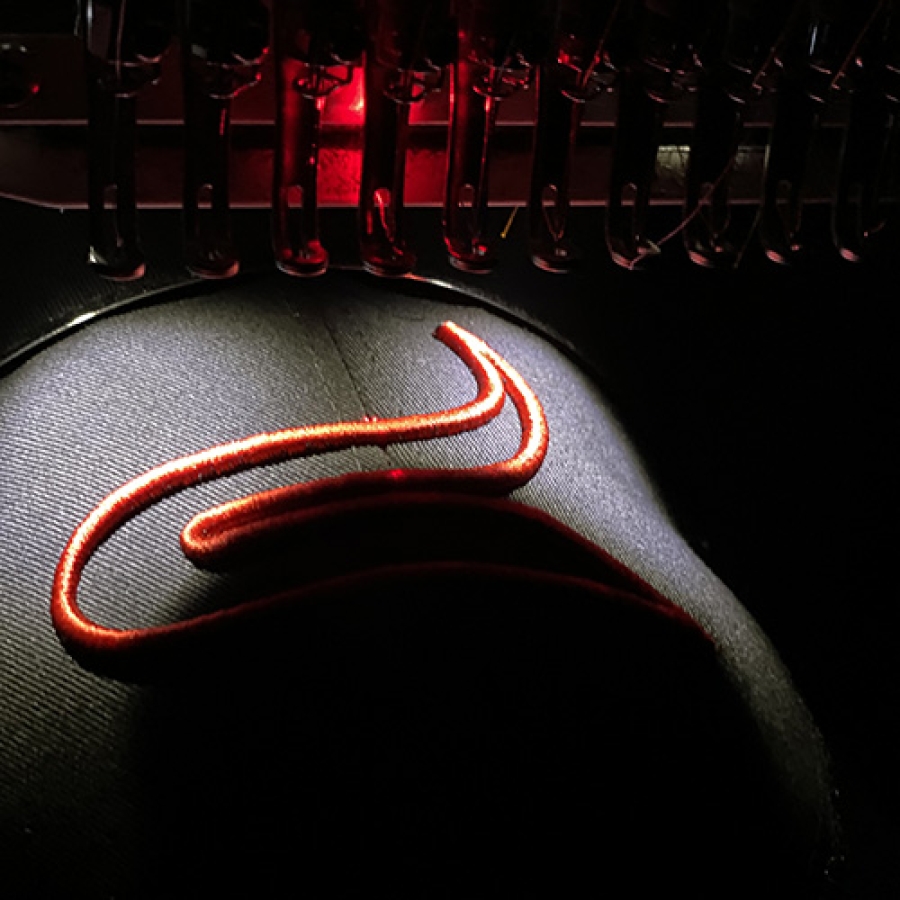Decoration & Branding Methods and Differences.
With so many different options out there for decorating your custom apparel or promotional products, how do you know when to use each method? Each decoration option comes with certain pros and cons as well as some limitations.
To make things easy, we have explained our most common forms of branding below.

EMBROIDERY
By far the most popular branding style. To turn your logo in to the embroidery format we must first digitise your logo. This means that we need to replace the colours and lines of your logo with threads. From here the appropriate thread colours are chosen and we do a sample. Once approved, your file is uploaded in to our massive industrial machines, the garments are "hooped" to stay in the correct position and after programming, the machine will start to embroider your logo on to the garment(s).
When to Use Embroidery as a Decoration Method
Embroidered logos typically look best on polos, jackets, woven shirts, caps, and bags, but this is a truly versatile style of decoration. We've embroidered just about every style of apparel & accessory on our site!
Embroidery is Ideal for…
- Polo Shirts
- Hats, Beanies & Visors
- Jackets & Outerwear
- Sweatshirts & Layering
- Backpacks & Bags
- Embroidered Towels & Blankets
- Much more
Benefits of Embroidery as a Decoration Method
- There is an added texture to the design.
- The product does not need to be laid flat like in printing, making embroidery suitable for hats and bags.
- The intricate design evokes a high perceived value and sense of professionalism.
- More durable and resistant to damage from washing than most decoration methods.
Drawbacks of Embroidery as a Decoration Method
- The number of colors used in the design is limited to the EMBROIDERY THREADS and prices typically increase with additional colors.
- Embroidery is only a suitable decoration method for fabric.
- Embroidery machines can struggle with small lettering or fine details in the design.

Screen Printing
An easy way to think about this is as a photographic stencil process. A stencil is created and then is used to apply layers of ink directly onto a product. The result is the screen's image transferred to the print surface. The versatility of this decoration method allows it to be used on a wide variety of items.
When to Use Screen Printing as a Decoration Method
Screen printing, also known as silk screen printing, is the most cost-effective method for large quantity print runs (around 50+ items) and works especially well with items like t-shirts and tanks. A complex design with many different colors requires different stencils for each color, so this decoration method is best for logos with 4 colors or less.
Screen Printing is Ideal for…
- T-Shirts
- Activewear & Sports Apparel
- Screen Printed Sweatshirts & Hoodies
- Promotional Pens & Custom Printed Notebooks
- Custom Drinkware
- Screen Printed Electronics
- Custom Golf Balls
- Much more
Benefits of Screen Printing as a Decoration Method
- Most cost effective decoration method for larger custom apparel orders.
- Just about any design and ink color can be applied to any product through screen printing.
- Ink is applied thicker than digital printing, making your design more vibrant and easier to see on darker fabrics or surfaces.
Drawbacks of Screen Printing as a Decoration Method
- The necessity to create screens means screen printing is not ideal for smaller order sizes or individually personalized items.
- Prices typically increase on orders with a high number of colors.

Heat Transfer Printing
If you have ever used an iron to press a decal onto a shirt then you know the basis of heat transfer, but our method is exceptionally more advanced. The digital heat seal decoration method utilizes regulated heat and pressure to thermally bond graphics onto a material’s surface.
When to Use Heat Transfer as a Decoration Method
Heat transfer, also known as digital transfer, is a great decoration choice if you are looking for affordable design options with unlimited colors. With decoration methods like embroidery and screen printing, you are using physical resources - thread and ink - to create a logo. This cost can be avoided with heat transfer, making it the most ideal decoration option for smaller orders.
Heat Transfer is Ideal for…
- T-Shirts
- Activewear & Sports Apparel
- Sweatshirts & Hoodies
- Backpacks & Bags
- Teamwear
- Team Uniforms & Jerseys
Benefits of Heat Transfer as a Decoration Method
- Minimal setup costs and equipment make heat transfers ideal for smaller order sizes.
- Affordable individually personalized decoration, such as sports uniforms.
- Allows for finer details and smaller text than embroidery.
- Heat transfer is available in many different finishes and styles.
- Environmentally friendly.
Drawbacks of Heat Transfer as a Decoration Method
- Logos and designs larger than 15 inches tend to be more expensive than other design methods.
- An image does not last as long as some other decoration methods and the printed area is not very breathable.
- Unable to use an iron on the printed area of the garment.
- When logos are too large the texture of the design can be thrown off.
- Should not be done on certain synthetic materials that can’t be exposed to the high heat from the iron.

DTG Printing
You can think about digital printing, or direct to garment printing, as a similar process to printing a document from your computer. An image is created with no restraints to the number of colors or type of artwork used, and the image is printed or affixed directly onto the material. With embroidery & screen printing, you are dealing with physical resources (thread & ink) to create a logo; with digital printing, full color, high definition logos can be done economically, even in small quantities.
When to Use Digital Printing as a Decoration Method
Commonly used as a substitute for screen printing on smaller orders, digital printing also works well with logos that require a high amount of detail or are very graphics heavy. This is also a commonly used option for logos that contain a gradient, as the print can closely match the digital version seen on a computer screen. Check out our breakdown of the differences between screen printing and digital printing here.
Digital Printing is Ideal for…
- Notebooks
- Water Bottles & Drinkware
- Electronics
- Promotional Products
- T-Shirts
- Activewear & Sports Apparel
- Printed Sweatshirts & Hoodies
Benefits of Digital Printing as a Decoration Method
- Easier set up than screen printing – no screen creation or color separation required.
- Ability to print more precise details in a broader range of colors.
- Great for smaller order sizes.
Drawbacks of Digital Printing as a Decoration Method
- Digital Printing is typically more expensive than screen printing for large orders.
- Certain Direct to Garment Machines can only print on 100% cotton fabric.
- Digital Printing is slower than screen printing for large orders.
- DTG Machines can struggle with printing multi-color designs on dark fabrics.
3D Embroidery
3D puff embroidery is done by placing a foam pad, or “puff”, onto your products and then having your embroidery machine sew an outline of your logo or design. Once this is complete you simply remove the excess puff around the outside of the embroidered outline and you’ve got a 3D design. You can read our complete step by step guide to custom 3D puff embroidery here!
When to Use 3D Embroidery as a Decoration Method
3D embroidery is used almost exclusively on custom hats and caps to give your logo or design depth and height. Outside of headwear, 3D embroidery is used on other heavy-fabric items like sweatshirts, hoodies, and workwear.
3D Embroidery is Ideal for…
- Custom Hats
- Sweatshirts & Hoodies
- Workwear
Benefits of 3D Embroidery at a Decoration Method
- Extremely durable – the design should outlast the garment itself.
- The logo is more noticeable because of the 3D design.
- More stylish and sophisticated look.
Drawbacks of 3D Embroidery as a Decoration Method
- Not ideal for intricate designs because of the thickness necessary to achieve the 3D appearance.
- More expensive than traditional embroidery because of the extra thread used.
- Not suitable for lighter weight fabrics.

Vinyl Transfer
This transfer process uses heat to activate and attach a vinyl sticker to a fabric. Vinyl is soft to the touch with great stretch and is durable enough for sportswear. You can read our complete step by step guide to custom vinyl transfer here!
When to Use Vinyl Transfer as a Decoration Method
Vinyl transfer has especially great durability. Perfect for uniforms and jerseys, as they are worn frequently and go through a lot of wear and tear. This decoration option is extremely dependable wash after wash.
Vinyl Transfer is Ideal for…
- T-Shirts
- Activewear & Sports Apparel
- Sweatshirts & Hoodies
- Custom Backpacks & Bags
Benefits of Vinyl Transfer as a Decoration Method
- The image is long lasting and durable.
- Your company logo or custom design is easily applied to any fabric or material that can absorb color.
- Vinyl transfer is a very affordable decoration method.
Drawbacks of Vinyl Transfer as a Decoration Method
- Preparing the vinyl design can be time-consuming.
- It is possible to add multiple colors to your design, but it requires you to layer solid colors to get there and that just adds time to the process.










